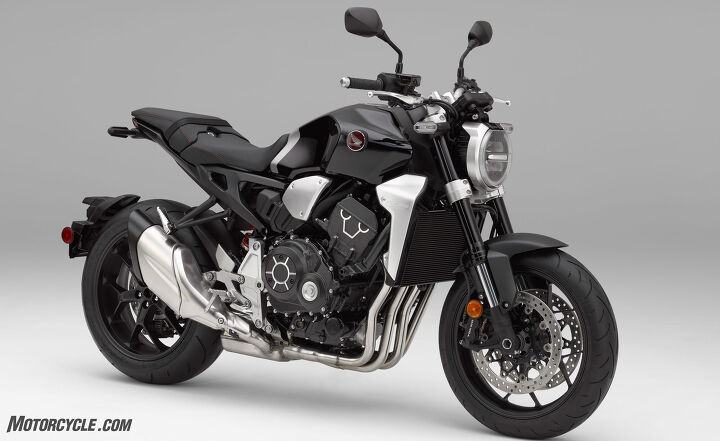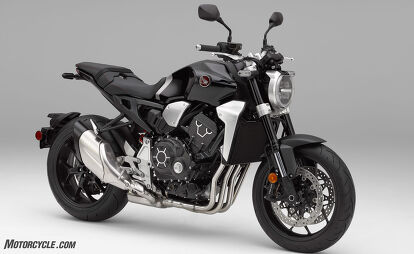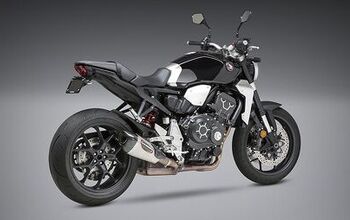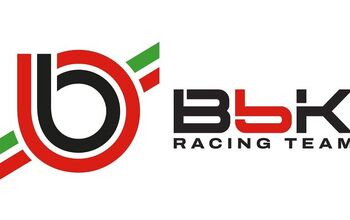First Look: 2018 Honda CB1000R

Performance upgrades and Neo-Sports Café concept styling
The Honda CB1000R, a legendary model from the company, had its latest iteration, the 2018 Honda CB1000R, unveiled today at EICMA in Milan. To escort the CB1000R onto stage for its debut was none other than five-time world champion Mick Doohan – a Honda legend in his own right.
Get the Flash Player to see this player.
Although there were performance upgrades that we will address in a moment, the most noticeable change in the big CB is its embrace of the Neo-Sports Café Concept we reported on here. Moving away from the typical naked superbike formula, Honda’s designers have added what they call “retro-industrial minimalism” which brings a variety of metal finishes that merge with “an ultra-minimalist look under the design theme of ‘Neo-Sports Café’.”
Honda Neo-Sports Cafe Concept Revealed At Tokyo Motor Show
This new approach plays out in the form of a more compact, trapezoidal profile. Starting with a 90mm (3.5 in.) shorter headlight and ending with an abbreviated tail section (thanks to the first ever for Honda swingarm-mounted fender), the overall look is that of a shorter motorcycle. To aid in the abbreviation, the pillion hand holds are underneath the tail unit. All of the visible metal, from the muffler heat shield to the tank/seat interface to the radiator guard, highlights the angular profile. Burns will be happy to know that the gas tank has no visible seam.
Hidden under that sculpted metal is a new mono-backbone steel frame which uses split-tightening aluminum pivot plates (for a 2.5 kilograms (5.5 lbs.) weight savings) to clamp the 14.7mm shorter single-sided swingarm, which is now 574.2mm (22.6 in.). Rake is a sporty 25° and trail is 3.9 in for quick handling. While the wheelbase is 10mm longer than the previous generation, the big CB’s weight dropped by 26.5 lbs. with a 48.6%/51.5% front/rear weight bias. That in addition to the crankshaft center being 5mm higher adds to the CB1000R’s side-to-side agility.
Supporting the new chassis is a Showa Separate Function Fr Fork Big Piston unit (SFF-BP) while a fully-adjustable Showa shock handles the rear. The front tire remains a 120/70 ZR17 item, and the rear becomes a 190/55 ZR17. Braking comes courtesy of dual radial-mount four-piston calipers squeezing 310mm floating discs. Out back a two-piston caliper handles a 256mm disc. Of course, two-channel ABS handles the braking modulation when you need it.
The CB1000R’s engine is a 998cc DOHC four-cylinder engine, sharing its architecture and layout with the CBR1000RR. While bore and stroke remain 75mm x 56.5 mm, compression ratio is to 11.6:1 (an increase of 0.4). The pistons are now forged, as on the CBR1000RR SP.
All of the flow into and out of the cylinders has been revised. The airbox and ducting were updated for smoother routing of air into the engine. An 8mm larger throttle body measures in at 44mm, and both the intake and exhaust valves receive higher lifts, 8.5mm and 8.1mm, respectively. The exhaust is a 4–2–1 unit, which feeds via 4 short catalysers into a main chamber before sending gasses out through a dual chamber muffler. Honda claims torque from 5,000 rpm and higher is boosted by a link pipe that joins the two main pipes just before the catalyzers. In addition to the performance upgrades, the exhaust system is 9.9 lbs lighter and has a new, throatier note at 5,500 rpm and higher.
While the tuning was focused on torque in the 6,000–8,000 rpm-range for real world power delivery, the reworked for 2018 engine now reaches a peak of 107 kW (143.5 hp) at 10,500rpm and 104Nm (76.7 lb-ft) at 8,250 rpm – both measured at the crankshaft. However, thanks to shorter gearing, the power delivery will come on even stronger in the mixed-speed environment of the urban jungle. Even with the increased power and shorter gearing, Honda claims improved fuel efficiency with 40.5 mpg.
Additionally, Ride-by-Wire (RbW) has been added. Of course, ride modes have also made the bill with three pre-set modes (Rain, Standard, and Sport). Three engine characteristics are controlled by the ride modes: Engine Power (P), Engine Brake (EB) and Honda Selectable Torque Control (HSTC). A user-adjustable mode is also available allows the user to create their own P,EB, and HSCT recipe and save it for future use.
But wait! There’s more! Honda has an accessorized CB1000R+ that features the following factory accessories pre-installed: heated grips, aluminium front fender panels, aluminium rear hugger panels, flyscreen with aluminium inserts, single seat cowl with aluminium inserts, radiator grille,with CB1000R logo, and quickshifter.
While this all sounds pretty exciting, we have a smidge of bad news. The 2018 Honda CB1000R and CB1000R+ will not be available stateside until the summer of 2018. Or you can simply move to Europe where it will arrive in early–2018 if you can’t wait.
2018 Honda CB1000R Specifications | |
|---|---|
| Engine Type | Liquid-cooled DOHC In-line 4 cylinder |
| Displacement | 998 cc |
| Bore x Stroke | 75mm x 56.5mm |
| Compression Ratio | 11.6:1 |
| Power | 107kW @ 10,500rpm (claimed) |
| Torque | 104Nm @ 8,250rpm (claimed) |
| Fuel Injection | PGM-FI, 44 mm throttle body with full Ride by Wire (RbW) |
| Exhaust | 4–2–1 |
| Emissions Standard | Euro 4 |
| Gearbox | 6 speed |
| Final Drive | Chain |
| Clutch | Wet, multiplate clutch |
| Frame | Steel mono backbone |
| Front Suspension | Showa SFF-BP USD fork, fully adjustable |
| Front Tire | 120/70 ZR17 |
| Rear Suspension | Showa BRFC (Balance Free Rear Cushion) |
| Rear Tire | 190/55 ZR17 |
| Front Brake | 2 x radial-mount Tokico four-piston calipers, 310mm double disc, ABS |
| Rear Brake | Two-piston Tokico caliper, 256mm single disc, ABS |
| Dashboard | LCD |
| Wheelbase | 1,455 mm (57.3 in) |
| Rake | 25° |
| Trail | 100 mm (3.9 in) |
| Fuel Tank Capacity | 4.3 US gal |
| Wet weight | 467 lbs (claimed) |
| Seat height | 32.7 in. |

Like most of the best happenings in his life, Evans stumbled into his motojournalism career. While on his way to a planned life in academia, he applied for a job at a motorcycle magazine, thinking he’d get the opportunity to write some freelance articles. Instead, he was offered a full-time job in which he discovered he could actually get paid to ride other people’s motorcycles – and he’s never looked back. Over the 25 years he’s been in the motorcycle industry, Evans has written two books, 101 Sportbike Performance Projects and How to Modify Your Metric Cruiser, and has ridden just about every production motorcycle manufactured. Evans has a deep love of motorcycles and believes they are a force for good in the world.
More by Evans Brasfield


















































Comments
Join the conversation
www.coskunbisiklet.com
They have hit the nail on the damn head. Other OEM's take note- you can make a round headlight look futuristic.